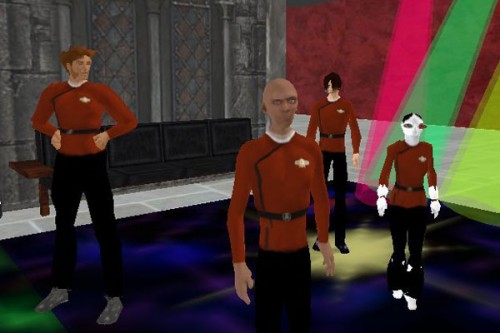
Star Trekking in Second Life, courtesy of Something Awful
Last weekend, I attended the first day of the Metaverse U conference hosted by Stanford University. I’d hazard around 50 people had made the trip, there to hear about “virtual worlds.” This year’s theme was most definitely the technical platforms on which virtual worlds could be run. While an interesting topic, I was there, waiting in baited breath, for some mention of MMOGs. I felt the discussion was focused on the Second Life-style freeform “social space” virtual world, although others felt differently.
This led me to thinking about the different virtual worlds we have, whether we have different research communities, and how we can define them. Read more after the jump.
In “Designing Virtual Worlds“, Richard Bartle describes virtual worlds as having some form of physics that allow players to enact change in the world, players represented in world in with a character, real-time interaction inside a shared, persistent world. Such a broad categorization includes Second Life and World of Warcraft, yet few would argue that these are not very different spaces that serve different audiences. More importantly, it seems that the issues that concern the communities around these platforms are very different. I also don’t believe that MMOs are usefully studied as entirely a video game problem: the nature of shared, persistent space with communities transforms the design issues.
Metaverse U, for me, was most interesting when it pushed at the boundaries of what it means to collaborate as embodied presences. I particularly enjoyed ScienceSim, an embroynic work that brings visualizations of scientific experiments to the metaverse. Having multiple people sit an analyze the same visualization as it happens definitely seems to be adding something to the conversation. However, such work is a very different focus than the writings on Terra Nova, one of my favorite blogs. The TN staff also describe themselves as virtual worlds researchers, but their discussion on economies, player populations, architecture and such include a majority of discussion of gaming spaces. Perhaps the reason for this is that online games are very good at reaching large audiences, which makes it attractive to study for many fields of research. The estimated population numbers speak for themselves. Separating out limited spaces such as Club Penguin, that don’t really offer a rich variety of interactions, games are leading the online pack. There is a stark comparison between the success, in pure numbers of subscribers, of games and social worlds. Indeed, at Metaverse U, the charismatic Henrik Bennetsen discussed how “virtual worlds” were on the comedown from a hype cycle, in the same week that Free Realms announced two million users.
It appears to me that we have two distinct, if not parallel, research communities, both describing themselves under the superset banner of “virtual worlds”. However, it’s not that we don’t have other usable terms. Games have “MMOs”, although no tag has managed to stick to social spaces.
That being said, perhaps looking for a distinction won’t be necessary for much longer. It is likely that we will see MMOs offer more and more affordances, such as City of Heroes User Created Content, which is going to position MMOs as social spaces as well. Bartle wrote in Third Person (a PDF version of a talk based on the essay is available) that there are three types of MMOs:
- Alice, from Alice in Wonderland: Alice wants to explore a world she finds interesting, and is happy to do that for the fun of it. This is the old, “balanced” MMO).
- Dorothy, from Wizard of Oz: Dorothy is wary of the world, and wants a path that she can just follow. This is the WoW model.
- Wendy, from Peter Pan: Wendy lives in a dream world of her own creation, which is the UCC/”social spaces”/Second Life model.
Bartle posits that the Wendy avenue won’t work for games, as gamers aren’t good game designers. He suggests that a game that moves from the newbie-friendly Dorothy model onwards to the Alice model will create rich experiences. Unless the pure social space is able to continue holding out its niche, I think the generations that grow up with games, and grow up with MMOs specifically, won’t have a problem with seeing a game as a social space. Game designers will implement user created content into their MMOs. Players can be Alice, Dorothy and Wendy, a game for all people. Players will naturally be drawn to the VW where their social network resides, and, as we’ve seen, games are doing very well at attracting large numbers. Note that this game won’t be as confusing or as hodge-podge as it sounds. We can see that players are already able to switch between gaming and social contexts very quickly, whether it be in WoW or in Facebook.
It’s wonderful that we have people working so enthusiastically in both the social and gaming spaces, but as virtual worlds continues to rapidly expand its borders, so too must there be a redefinition of where the lines are. It’s certainly hard to find those edges now, and it seems that it will become more difficult as technology moves onward. However, if we’re going to continue recognizing, understanding and championing significant research, there may need to be an acceptance that there are two separate research communities, or for everyone to continue working hard to be inclusive to both.
Until that point, we may have to obsolete our old friend, “virtual worlds”. We’re going to need some new terms. Perhaps we’ll go for “Wendy”, “Dorothy” and “Alice”.

